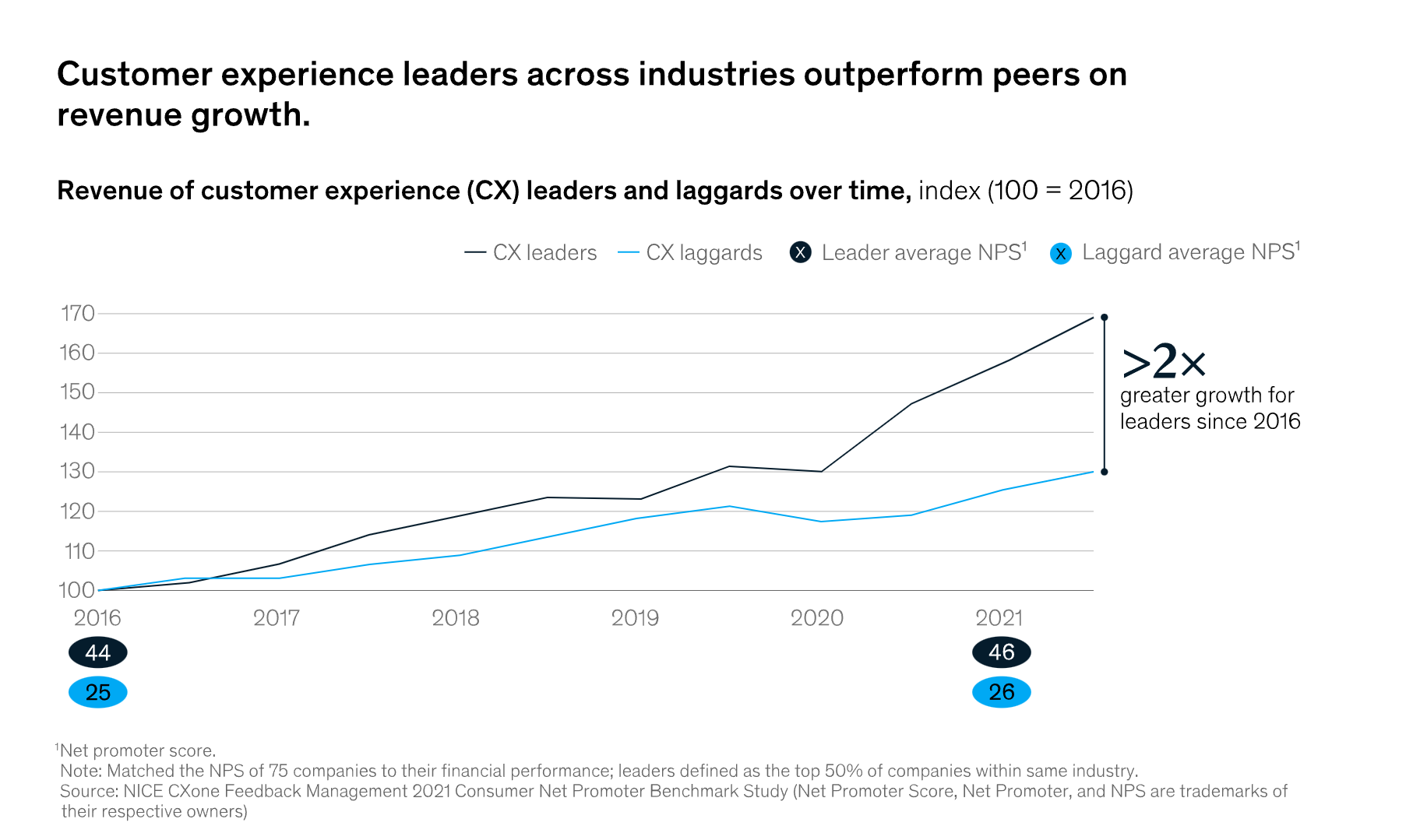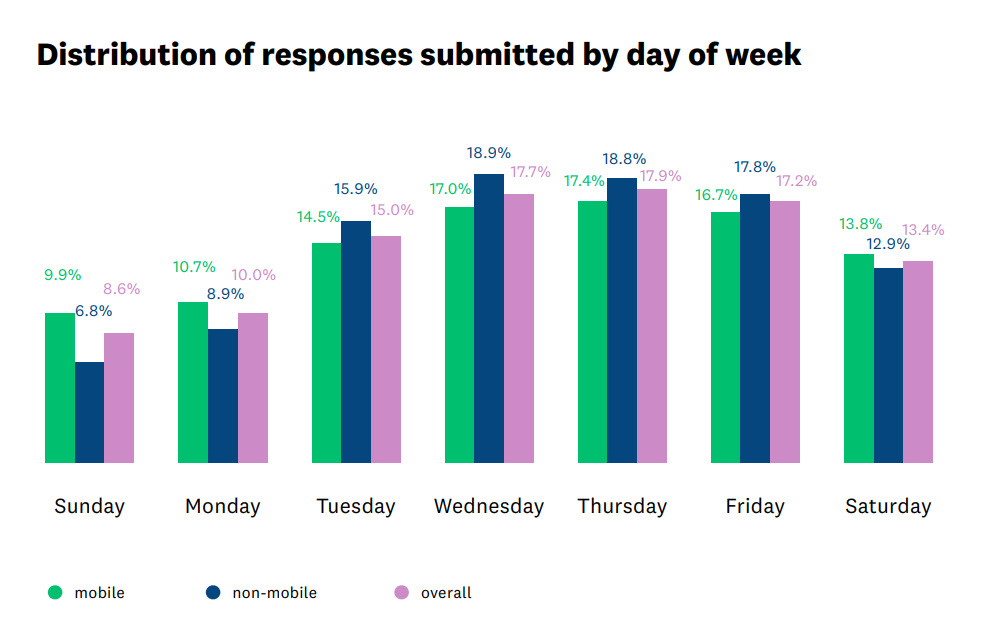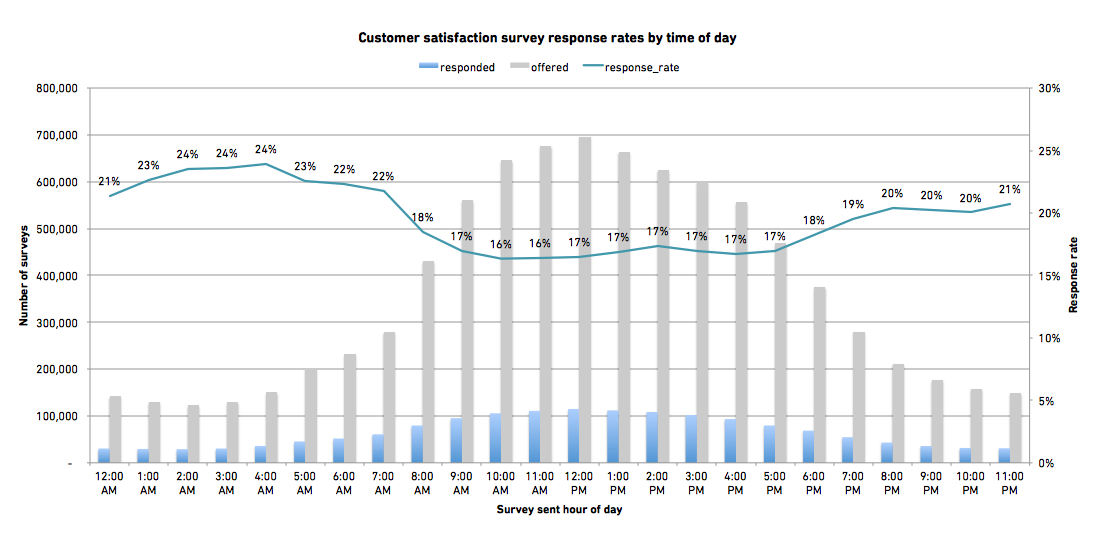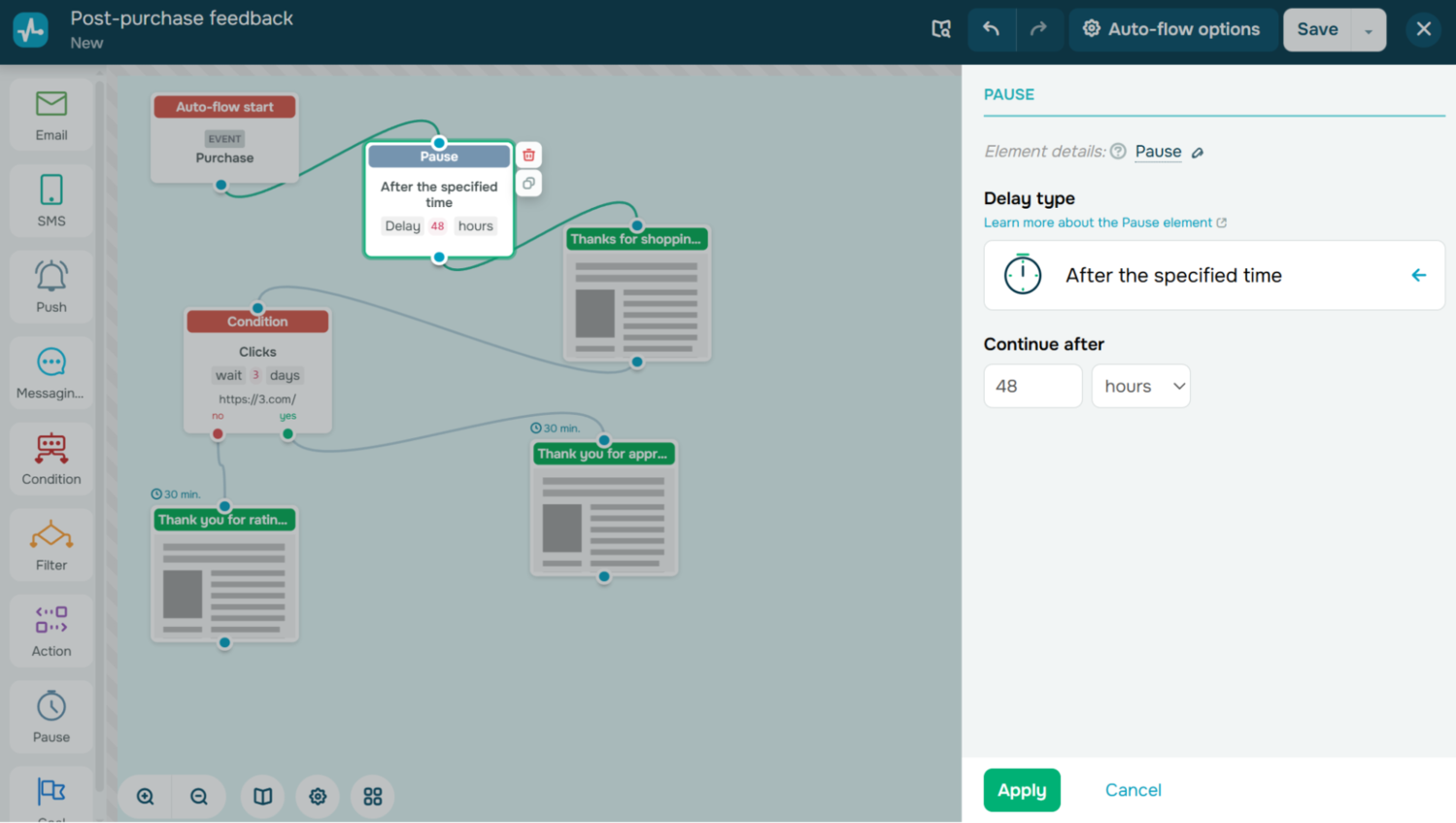How do you really know what your customers and users think, beyond guesses, clicks, and conversion rates? You ask them. Customer survey emails are one of the simplest ways to start that honest conversation. They help you collect real opinions, measure satisfaction, and discover what your audience actually wants from your brand.
In this post, we’ll uncover practical tips to create effective email surveys, explore when is the best time to send them, and analyze how different brands write survey emails that invite a response.
What is a survey email?
An email survey is a marketing tool that helps your business move from guessing to truly understanding your audience. While promotional campaigns are built to inform or sell, survey emails are meant to listen. They shift the focus from pushing messages to starting conversations and turn customer opinions into a clear direction for your next move.
For marketers, survey emails are a simple yet powerful way to test ideas and see how customers actually experience your brand. They combine reach with relevance, which lets you engage many people at once while still gathering authentic, personal feedback. Customer survey emails have the potential to close the loop between brand and audience and turn communication into a genuine connection.
Key email survey distribution methods
A survey can be shared with your subscribers in two main ways. The method you choose to send a survey to your customers will dictate how they interact with it.
Embedded surveys
Embedded email surveys, also called email inline surveys, include interactive elements, such as star ratings, emojis, or one-click responses, placed directly inside the email body. They allow recipients to respond without leaving their inbox.
This distribution method works best for short, single-question feedback requests, for example, “How would you rate your recent purchase?” Because it’s simple and immediate, this approach often results in higher response rates.
Redirect surveys
Redirect surveys include a call-to-action button or link that leads recipients to an external survey page created with dedicated tools. It is an ideal format for longer surveys with multiple open-ended questions that require detailed input. Being made with specialized survey tools, they give you richer analytics, allow you to set up your survey branching logic and customize its design.
While embedded and redirect formats are the most popular, sometimes, you should consider experimenting with hybrid strategies to boost survey engagement. Say, starting with an embedded rating within the email and then redirecting users to a more detailed follow-up form.
If you use an email marketing platform like SendPulse, you can easily combine these approaches within a single campaign. Embed quick feedback elements directly into your email and automatically trigger a survey follow-up email after key customer interactions or send survey reminder emails.
Check out our 90-second video about how SendPulse helps you with all kinds of email campaigns:
Why customer survey emails matter for businesses
Survey emails turn one-way communication into genuine dialogue. Instead of simply pushing content or offers, they invite customers to participate, turning passive readers into active contributors to your brand’s growth. Each response provides valuable insight into what drives satisfaction, loyalty, and engagement, and reveals where new opportunities may lie.
When sent at the right moments – after a purchase, completing onboarding, or interacting with a support team – surveys help capture authentic, actionable feedback that strengthens the overall customer experience. According to McKinsey & Company, businesses that prioritize improvements to the experience of their existing customers get more than twice the revenue growth of their competitors.
 The link between customer experience and revenue
The link between customer experience and revenue
The insights gathered from well-thought-through email survey questions reveal not just what customers think, but why they feel that way. The impact of those insights extends across every area of your business, from customer experience to marketing, sales, and brand perception.
A well-crafted email survey helps you:
- Improve customer experience and loyalty. Surveys uncover what your customers love and what frustrates them, helping teams identify and fix pain points before they grow into major issues. Listening to and acting on feedback also strengthens loyalty by showing that customer voices matter.
- Guide smarter business decisions. Survey results provide a potential direction for growth. They help shape product development by showing what features or products users are excited to try and what is missing or could be improved.
- Optimize marketing and sales. The insights gathered from email survey questions contribute to precise, accurate audience segmentation, allowing you to tailor campaigns to their genuine interests and needs.
- Strengthen your brand reputation. A thoughtful feedback loop turns satisfied customers into brand advocates. You align your strategy with customer expectations, and people feel appreciated – becoming more likely to leave positive reviews and recommend your brand to others.
Main types of survey emails with examples
Even though all of them are about asking questions, email surveys might serve different purposes. Some help you measure satisfaction, others reveal how likely customers are to recommend you, and some simply explore audience preferences. So, what’s your type? Let’s find out!
Customer satisfaction survey emails
These emails focus on how satisfied customers are after their interaction with your brand, for instance, when a customer is actively using a feature for the first time or shortly after a successful product delivery. They help identify what went smoothly and what could be improved while showing customers that their experience matters. Sending your survey email soon after the interaction, when impressions are still fresh, ensures more accurate and helpful feedback.
Mack Weldon keeps their customer satisfaction survey email short and clean, asking for a quick star rating right after purchase.
Net promoter score emails
An NPS email invites respondents to answer one core question: “How likely are you to recommend us to a friend or colleague on a 0-10 scale?” It’s best to send it once the customer has had enough experience with your product or service to form a fair opinion, for example, after onboarding, reaching a milestone, or making several purchases.
This simple email survey provides a clear measure of customer loyalty and advocacy. It helps you segment clients into Promoters, Passives, and Detractors so that you can adjust your follow-up strategies accordingly. Below is a great example from bellroy that illustrates a well-designed, engaging NPS email:
Product feedback survey emails
These emails gather opinions about specific products or features – what users appreciated, what could be improved, and what they expect next. They’re usually sent after delivery or once a trial period ends, when customers can provide thoughtful, experience-based feedback.
Going’s survey email stands out with a personal tone and focus on a single question, which reduces friction and encourages honest feedback.
Post-event survey emails
This type of survey email is sent after an event, such as a webinar, conference, workshop, or virtual meeting. It is usually delivered within 24–72 hours post-event and aims to understand attendees’ experiences and gain feedback regarding the venue, speakers, agenda, networking opportunities, overall organization, etc. A simple message like “Thanks for attending [Event]! Your feedback helps us improve for next time.” with a short survey link is often all it takes to encourage responses.
Here’s a transparent and concise survey email inviting users to reflect on their experience after the recently attended event:
Market research emails
These emails aim to gather broader insights about customer preferences, behaviors, and future product ideas, rather than just immediate feedback on purchases. They’re helpful when planning marketing campaigns, testing concepts, or exploring new audience segments.
Sight Glass illustrates this approach well. Its email invites customers to share opinions in a friendly, conversational tone. The minimalist design reflects the brand’s aesthetic, making participation feel like an authentic part of its ongoing relationship with customers.
When is the best time to send survey emails?
Timing is one of the most significant factors that determines your response rate in survey emails. Research shows that the best time to send a survey is mid-week, from Wednesday to Friday, early in the morning, around 4 a.m. local time. At this time, people are most likely to open, read, and complete your survey.
SurveyMonkey’s research found that almost 80% of all survey responses come in on weekdays, while only 22% are submitted on weekends. Among weekdays, Wednesday, Thursday, and Friday consistently deliver the highest completion rates. Sunday and Monday tend to perform 2-3 percentage points lower than average. Although Tuesday and Saturday hover around the middle, sending surveys mid-week remains the most effective choice for higher engagement and fewer drop-offs.
 Best day to send survey emails according to SurveyMonkey report
Best day to send survey emails according to SurveyMonkey report
Zendesk’s findings support that insight and highlight another important detail: the time of day matters. Emails scheduled for late at night or very early in the morning, around 4 a.m., usually do best because they appear at the top of users’ inboxes when they first check email. Moreover, surveys sent about ten hours after a meaningful user action, such as a plan downgrade or a resolved ticket, lead to higher completion rates since the experience is still fresh.
For mobile users, weekend participation is slightly higher, with 24% of mobile responses compared to 20% on desktop. Still, even for mobile audiences, mid-week surveys are far more likely to be completed, as people are back to their routines and ready to engage with structured tasks.
 Best time to send survey emails according to Zendesk
Best time to send survey emails according to Zendesk
To make timing work to your advantage, consider using automation tools to trigger surveys right after key customer actions or schedule them to arrive mid-week, early in the morning. Avoid sending them during peak promotional hours, which are typically from 9 a.m. to 12 p.m. It is the time when inboxes are full of marketing messages, and your email risks getting lost.
SendPulse makes it butter-smooth for you to send your survey emails at the right time. Case in point: a person bought your product for the first time. Apart from sending an order confirmation email, it’s also very effective to follow up with them in a few days to ask whether they enjoyed your product or not.
Using our visual automation builder, you can set up a “Purchase” trigger to start the flow and add the “Pause” block to define when exactly your survey email should be sent. Besides, you can mix and match other elements to branch your flow based on customers’ actions.
 Setting up a post-purchase feedback flow
Setting up a post-purchase feedback flow
Tips for creating engaging survey emails
Great surveys balance clarity, timing, and simplicity. Below are survey emails best practices that will help you get more responses and make your surveys feel like a natural, positive part of your customer communication.
Keep it short and clear
People are far more likely to respond when surveys feel quick, relevant, and rare enough to matter. Sending too many feedback requests can lead to fewer responses and more people unsubscribing.
It’s best to send a survey when there’s a good reason – after a delivery, an event, or a key milestone – and to make it as concise as possible. Briefly explain what your survey is about and how you will use customers’ feedback. To give you an idea, a transparent “Help us improve your next shopping experience” or “Help us prioritize what to build next” is great for building trust.
Most users are willing to spend no more than a minute or two answering questions, so keep your message brief and focused, and clearly state how long it will take to complete, just like NordVPN does.
Make participation as effortless as possible
The easier it is to respond, the more people will do it. Keep interaction simple and intuitive: add a one-click rating, emoji reactions, or a short satisfaction scale inside the email, so recipients don’t have to leave their inbox.
If you’re using a link to a longer survey hosted elsewhere, make sure the CTA button stands out and invites clicks. Phrases like “Tell us what you think” or “Rate your experience” work much better than generic calls to action like “Take survey.” Take this email from Clear as an example:
Offer an incentive
Even a small reward can make a big difference in survey participation rates. The most effective incentives often vary based on the type of business involved.
For SaaS companies, offering early access to new features, extending trial periods, or inviting users to exclusive webinars can encourage more people to take part in surveys. Service-based businesses might incentivize participation with free consultations or access to premium resources. Meanwhile, eCommerce brands, like DeFeet, can offer their customers discounts, bonus points, or gift cards to show appreciation for their time.
Personalize and segment
Generic survey emails may go unnoticed, while personalized ones tend to build stronger customer connections. Effective personalization in this case relies on behavioral patterns, which means you group audiences by actions rather than demographics. For instance, users who signed up for a free trial or those who downgraded their plan will probably require different survey tones and questions.
Referencing recent interactions, such as testing a new feature, attending a webinar, or staying at a hotel, helps ground the message in context as well. Its tone may also vary depending on your relationship with the recipient. Loyal customers tend to respond well to direct questions, while newcomers appreciate a warmer, more encouraging approach. Even a subtle reminder of why the recipient’s feedback matters can make the request feel more meaningful – take a look at how Marriott does it.
Use reliable tools for a seamless process
Creating a successful survey email involves the right combination of tools to create a survey itself and deliver it to recipients via email. To design and manage your surveys, you can rely on dedicated tools like Typeform, Google Forms, or SurveyMonkey.
Typeform offers an intuitive way to build visually appealing surveys with flexible logic and complex branching rules. Alternatively, Google Forms is a simple, free option that’s great for quick sharing and collaboration. For teams that need more profound insights, SurveyMonkey offers advanced analytics, pre-filled fields, and seamless integrations with CRM systems and marketing tools.
These tools help you collect and organize responses, while SendPulse ensures your survey emails reach the right people at the right moment. Using the platform, you can:
- design unique, responsive survey email templates and send them to hyper-targeted segments;
- schedule survey emails to be resent to recipients who didn’t open them the first time;
- automate survey campaigns across any stage of the customer journey, for example, when users create a new account, get your product delivered, or cancel their subscription;
- integrate other communication channels like chatbots or SMS to follow up with respondents and increase completion rates.
Here’s what a personalized survey email template with an embedded feedback form powered by Typeform looks like:
 Building a survey email template with SendPulse
Building a survey email template with SendPulse
How to write a compelling survey email subject line
A subject line for your survey email is the first and often the only chance to get people to open it. To boost your open rates, keep your subject lines short and transparent about what’s inside. Below are some practical strategies and examples you can adapt for your own campaigns.
KISS
KISS is an acronym for “Keep It Short and Simple,” and that’s exactly the principle behind powerful survey email subject lines. The thing is, most inboxes display only 40–50 characters on desktop and even fewer on mobile, so clarity matters more than ever. Instead of long, complex phrases, use natural language that sounds like you’re speaking directly to the recipient.
Here are a few examples of that kind:
- Quick question for you 👋
- Got 30 seconds to help us improve?
- We’d love your feedback!
J.Crew takes this idea to the extreme with a one-word subject line for its survey invitation email: “Thoughts?” It feels personal and direct, almost like a quick message from a friend rather than a marketing email. This minimalism cuts through inbox noise. It is short enough to read instantly, but engaging enough to make people click.
Highlight the benefit
Let subscribers know why their feedback matters. Explain what they gain from sharing their thoughts. This makes them feel involved and valued. Try saying something like this:
- Help shape the next version of N
- Your opinion helps us serve you better!
Tillamook does this perfectly with its survey email subject line: “Your Feedback Is Important to Us.” It’s short and sincere, signaling right away that the recipient’s voice has a real impact.
Set expectations upfront
Including explicit time cues like “1-minute survey” or “5 quick questions” helps your subscribers immediately understand that your survey won’t take long. This kind of clarity reduces hesitation and encourages more people to open and respond.
Check out these examples — they set expectations, but keep the tone friendly and action-oriented:
- A 2-minute survey that makes a difference
- Tell us in one minute what you think
Flowium nails this approach with the survey email subject line “Have a second?” It’s casual, concise, and inviting, a phrase people naturally associate with a quick favor or friendly check-in. The wording implies that the request will be brief and simple to fulfill.
Personalize when possible
Industry data shows that emails with personalized subject lines can achieve open rates over 20% higher than those with generic or static lines. In SendPulse, personalization is handled through custom variables like {{Name}}, {{City}}, or any other attribute you gather from your subscribers. These variables can be inserted in your subject line, preview text, or within the email body to make each message more relevant.
To illustrate the idea, a survey request email could open with “John, we’d love your feedback on your recent purchase” instead of a generic greeting. This simple touch helps the message sound more personal and direct.
Spark curiosity
A touch of intrigue can go a long way as long as it feels genuine. The idea is to hint at something interesting without exaggerating or misleading. Take these as an example:
- Something new is coming, and we’d love your input
- Your experience matters more than you think!
- We’re planning some exciting updates. Want to help?
G2 nails this balance with the subject line “…and the best software is…” It instantly triggers curiosity because it starts mid-sentence, inviting readers to open the email to “complete the thought.” The phrasing feels conversational and suspenseful without resorting to gimmicks. It’s relevant to the brand, as G2 is known for rankings and reviews, so the curiosity feels natural and credible.
Test and analyze
The most effective subject line is the one that brings real results. A/B testing lets you experiment with tone, length, emoji, or other minor tweaks and then check open and click rates to see what resonates with a sample of your audience. SendPulse lets you split your mailing list, test different subject lines, and send the best-performing version to the rest of your subscribers.
Over time, tracking your best subject lines by survey type, like satisfaction, NPS, or product feedback, builds a reusable subject line library to make your future campaigns higher-performing.
Great customer survey email examples
The best survey emails are thoughtfully designed, intentional, and infused with your brand personality. Let’s uncover some real-world examples that show different ways to engage audiences.
Anthropologie: “Just a friendly reminder to complete our survey”
Anthropologie adopts a friendly and relaxed tone, making its request feel easygoing and natural rather than pushy. The email itself is simple, focused, and respectful of the recipient’s time. The brand offers a 20% discount as a reward, which fuels motivation to respond. Because the offer is limited in time, it helps the brand create a gentle sense of urgency and makes the incentive feel even more valuable.
Graza: “WE’LL TRADE YA”
Graza transforms its feedback request into a warm, conversational exchange that feels personal and fun. The email opens with a cheerful “Hello lovely person” and keeps that friendly tone throughout with humor and enthusiasm.
The promise of a 12% discount after completing a short, five-minute survey makes the interaction beneficial for both parties. With its casual language, emojis, and an authentic voice, the message perfectly reflects Graza’s approachable brand personality and turns a simple survey into a delightful brand experience.
Google: “Got opinions? We’re all ears”
Google’s subject line stands out as direct, engaging, and inclusive. The phrase “We’re all ears” signals that the brand genuinely wants feedback. It positions recipients as being part of something meaningful: their voice helps shape the platform and not just rate it.
The email also clearly states that the survey includes nine questions, comparing the time needed to that of watching a short video, which makes participation feel easy and manageable.
Ritual: “A couple of questions for you…”
Ritual’s email opens with warmth and familiarity: “We’re pretty well-acquainted now,” instantly making the recipient part of the brand’s community. The message clearly explains the survey’s purpose: the team wants honest feedback to keep improving.
By assuring that it “will only take a few minutes,” Ritual lowers the effort barrier. Moreover, the email signature from Emma, Customer Insights at Ritual, adds authenticity and a personal touch. The overall tone is friendly, transparent, and respectful of the subscriber’s time.
Create better survey emails with SendPulse
Successful survey emails have clear copy, show recipients that the survey matters, and arrive at the right time.
Need a solution to send your email surveys and other campaigns easily? Trust SendPulse to get the job done.
SendPulse helps you design feedback request campaigns that look professional, feel personal, and deliver real insights. With our drag-and-drop builder, you can craft branded emails in minutes without coding, while automation tools help trigger surveys based on meaningful customer interactions.
Sign up for your free account, and you’ll be up and running in just a few minutes.